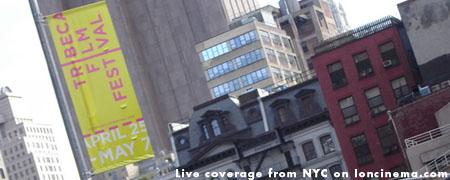[Pierre-Alexandre Despatis suffers for his cinema. Now covering his second edition, our official festival reporter and multi-function human cyborg will provide us the sights (plenty of cool pics!), the sounds, the reviews and the occasional interviews of the still very young 5th edition of the Tribeca film festival. Below are some of Pierre-Alexandre’s reviews in easy to read, insightful capsule form. Enjoy!]
WINDOWS
Somewhere between experimental cinema and narrative film is a little and strange film called WINDOWS. The film is composed of 9 stories revolving around … windows. Each of the stories is shown in one single continuous shot. Yes, this could be a rather boring experience but we spectators are surprisingly active during the films, as we're trying to figure out what is going on based on the clues that gradually get revealed via a slow-moving camera. Certain elements of the films are somewhat annoying–for instance in one of the short films the characters in the background have sex without totally giving themselves to the scene and sometimes the camera movements are shaky and unstable. Despite such small glitches– Shoja Azari manages to add some artiness to the film, each of the 9 stories is compelling enough to give an end result that is both pleasant and challenging. WINDOWS has something for everybody, even for those who aren't particularly fond of experimental cinema.
WAH-WAH
Simply put, the film which marks Richard E. Grant's directorial debut is nothing short than a masterpiece. It's not surprising that the film has been shown in so many major festivals, including Edinburgh and Toronto. After a promising start, WAH WAH, Grant’s semi-autobiographical coming-of-age story, finally made it to New York. Set in 1969, WAH WAH relates the difficult life of a young white boy who lives in Swaziland and who has to cope with his parents' zealous acts everyday. It's a poignant story shot with ingenuity; for example, at a croquet game, the scoreboard is used to mark the passage of years. The film is full of those small creative touches which greatly enhance it. The film's numerous contrasts (classes, race, etc.) are further enhanced by many contrasts in the structure of the film; one minute you're happy, the second, the film takes an abrubt dramatic turn and you're almost bursting into tears. Just like A WOMAN UNDER THE INFLUENCE, WAH WAH is a difficult film to watch due to the many unfortunate (!) events that happen to the young teen, but the film is also extremely rewarding to watch, thanks to the many memorable moments, inventive filmmaking style and unpredictable plot.
ROCK THE BELLS
The film follows events promoter Chang Weisberg during his preparation for the ROCK THE BELLS hip hop festivals in 2004. Despite all the problems, which range from the uncooperative police, broken equipment, very demanding artists and, mysteriously missing armed security guards, they eventually get started. That is, getting started without being sure that all the members of the Wu-Tang Clan would be there, as they promised their audience. The film is really about the production of the festival and not about hip hop itself. Many people who didn't like hip hop at the screening still enjoyed the film as a whole because it's utterly funny, witty and somewhat unrealistic given the high goals Weisberg had set for the festival. Hip hop fans will find this film of great interest too for the behind the scene footage and numerous–and often hilarious–interviews with hip hop stars. ROCK THE BELLS isn't the kind of film that is life altering, but it's never boring and makes up for a nice watch.
WATERBUSTER
While the subject of the film–a documentary about an native reserve that has been flooded to make room for a dam reservoir–is not a new subject and has been exploited ad nauseam in the past, especially in Quebecois cinema, , this film uses a whole new perspective. Rather than showing the native while they are at war against the "white bureaucrats", the films picks up with the tribe whose territory was flooded several decades after the events. As one of the tribal member says in the film, "we can't no longer blame the bully man for what's happening to us" … several decades after the tribe has been relocated, only they can take the future of their tribe in their own hands. J. Carlos Peinado documents the journey of filmmaker (a direct descendant of the tribe) as he tries to understand the impact the relocation has had on his community. Often activist documentaries lack a little something at the level of aesthetics. WATERBUSTER succeeded however at having a nice look and the film is greatly enhanced by many amazing archive films depicting the community when it was at its best. In addition to the insightful and very touching interviews, the archival footage makes you wish this isolated wonderland was still there … which most activists documentaries fail to achieve since they concentrate on the outer conflicts.
